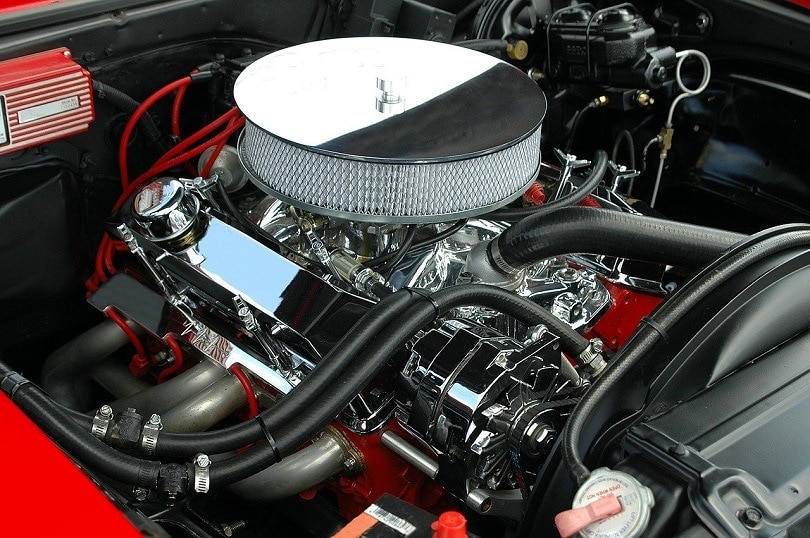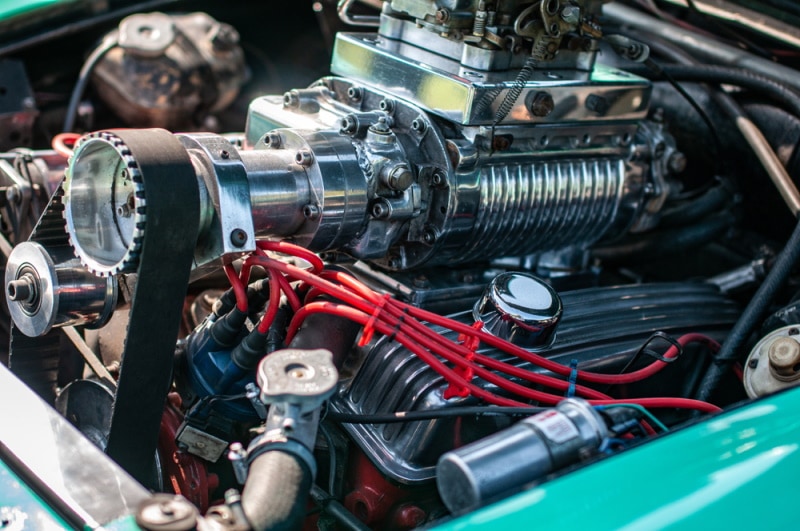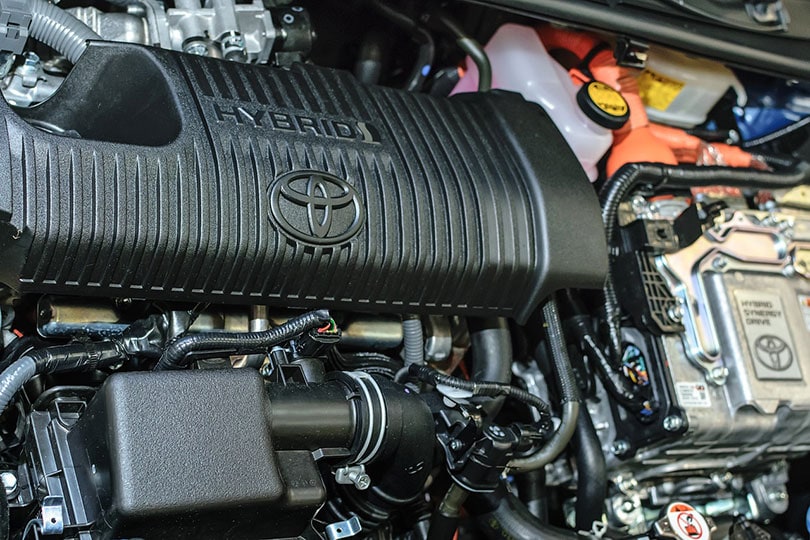18 Different Types of Car Engines (with Pictures)
-
Ed Malaker
- Last updated:

If you are interested in engines or are looking to become a mechanic, it can be helpful to learn about all the different types of car engines in use. There are quite a few engines in production, and each one has something unique to offer. Keep reading as we look at engine size, strokes, ignition method, and more.

The 18 Different Types of Car Engines
The 3 Stroke Engines
1. Two-Stroke Engine
| Characteristics: | More power, simple design |
| Uses: | Lawnmowers, chainsaws, weed whackers, motorcycles |
A two-stroke engine requires two strokes to complete one crankshaft revolution, which is how it gets its name. These engines are more efficient than the more popular four-stroke engine, and they have a higher power-to-weight ratio. They have a simple design and were used in a few cars during the 1960s, like the Sonnett II. Modern, non-electric cars use a four-stroke engine. We primarily use the two-stroke engine in lawnmowers, chainsaws, and similar devices.
The downside of this engine is that it burns fuel and oil together, creating considerable emissions that are bad for the environment.
- Simple design
- More efficient
- Lightweight
- High emissions
2. Four-Stroke Engine

| Characteristics: | Fewer emissions |
| Uses: | Almost every passenger vehicle that is not electric |
A four-stroke engine uses four unique piston strokes to complete one crankshaft revolution. The intake stroke supplies an air-fuel mixture to a combustion chamber. The compression stroke compresses the air-fuel mixture, which enables more energy to be released when the mixture ignites. The power stroke ignites the mixture using a spark plug, and the force pushes the piston away from the cylinder head, creating the power needed to move the vehicle, and the exhaust stroke releases the vapors from the ignition. Since this type of engine uses a separate system for lubrication, no oil burns and fewer emissions result. Since these engines are better for the environment, it’s the most common type used in vehicles.
The downside to four-stroke engines is that they do not create as much power as the two-stroke engine, and they are also quite a bit larger and heavier. (University of Windsor)
- Fewer emissions
- Separate oil and fuel system
- Heavier
- Not as powerful
- See Also: What Is The Cost To Replace Spark Plugs
3. Six-Stroke Engine
| Characteristics: | Fewer emissions |
| Uses: | Modern Vehicles |
A six-stroke engine is the newest type to be developed. It’s a continuation of the four-stroke design but uses two additional strokes to increase efficiency and reduce emissions. It uses less gas, creates less heat, and releases less noise and pollution into the environment.
The downside to the six-stroke engine is that it’s still relatively new, and you don’t see them in many vehicles yet.
- Fewer emissions
- Less noise
- Fuel efficient
- Still being designed
- Still requires fossil fuel

The 5 Design Engines
4. Reciprocating Engine
| Characteristics: | Piston and cylinder |
| Uses: | Most Vehicles |
A reciprocating engine uses a piston and cylinder to convert the pressure created by the engine into rotation. The reciprocating engine is the most common type used in vehicles, and the force of the gas explosions moves the pistons inside the cylinder to create motion in the axel. More pistons will give you more power.
- Common
- Complex design
- Requires a large amount of space
5. Wankel Engine
| Characteristics: | Rotary design |
| Uses: | Racing vehicles |
A Wankel engine has a more compact design than the reciprocating engine. It also operates smoother because it relies on a rotary motion instead of the up-and-down motion of the pistons, and many people call them rotary engines. It often produces more power pulses per revolution, which means it will use more fuel than the reciprocating engine, but the extra power makes it popular in racing cars.
The downside to the Wankel engine is that it uses more fuel, so it’s not common in standard vehicles.
- More power
- Smoother operation
- Requires more fuel
6. HCCI Engine

| Characteristics: | Uses elements from gasoline and diesel engines |
| Uses: | Still in design |
The HCCI engine is a homogenous charge compression engine that combines elements from both a gasoline-powered engine and a diesel engine to create a more efficient hybrid that minimizes harmful emissions and maximizes fuel efficiency.
The downside to these engines is that they are still being designed, and the only ones that you are likely to see are prototypes.
- More efficient
- Fewer emissions
- Still in the design stage
7. Electric Engine
| Characteristics: | Uses batteries instead of fuel, no emissions |
| Uses: | New vehicles |
Electric motors have been around for a while but have become more popular as people are becoming more environmentally conscious. These cars do not release the dangerous greenhouse gases that fossil fuel releases, and they are more efficient.
The downside to these engines is that they are still quite expensive, and there are not many places to charge them. Dead batteries also pose another environmental problem.
- No fossil fuel
- More efficient
- High cost
8. Hybrid Engine

| Characteristics: | Uses electric components to reduce fuel consumption |
| Uses: | New vehicles |
A hybrid engine combines a traditional gasoline engine and an electric one. It’s extremely popular because it doesn’t require charging, significantly reduces air pollution, and provides enough power to get you to your destination. Many newer car models have a hybrid engine, and the trend is likely to continue for several years.
The downside to these engines is that since they are still a relatively new technology in vehicles, they tend to be more expensive than the traditional gasoline versions.
- Uses less fossil fuel
- More efficient than gasoline
- High cost
The 2 Ignition Method Engines
9. Compression-Ignition
| Characteristics: | No spark plug |
| Uses: | Diesel engines |
A vehicle that uses compression ignition does not require a spark plug because it ignites the fuel using heat from the compression alone. The downside to this design is that the temperatures are too high for gasoline, so you’ll need to use other fuel types, like diesel.
- No spark plug
- More thermodynamically efficient
- Requires diesel fuel
10. Spark Ignition
| Characteristics: | Spark plug ignites the fuel |
| Uses: | Most vehicles |
The spark ignition is the most common type of ignition in passenger vehicles. It uses spark plugs to create a spark to ignite the air-fuel mixture in the power cycle of a four-stroke engine, and since the spark ignites the fuel, you can use gasoline. The downside of the spark ignition method is that you need to calibrate the plugs with a special tool to ensure that the spark is the right size. The plugs also wear out every few years and require replacement.
- Uses gasoline
- Extremely common
- High maintenance
The Number of Cylinders in Engines
11. Single Cylinder
| Characteristics: | Spark plug ignites the fuel |
| Uses: | Most vehicles |
Many people choose their engine based on the number of cylinders that it has, and you can choose either a single- or a multi-cylinder engine. Single-cylinder engines are small, efficient, and good on gas, but they aren’t used in many modern cars. They are commonly in smaller vehicles, like motorcycles and go-karts.
The downside to the single-cylinder is that it doesn’t provide enough power to move a large vehicle carrying passengers.
- Small
- Efficient
- Low power
12. Multi-cylinder

| Characteristics: | More power |
| Uses: | Most vehicles |
The multi-cylinder car is the type that you will find in your standard gasoline or diesel-powered vehicle. The more cylinders, the more power the engine will provide. The eight-cylinder engine was popular for many years before we became aware of the environmental impact of gasoline engines. Modern cars have reduced the number of cylinders to six or four, without sacrificing much power, to make the engines better for the environment.
The downside to these engines is that even with many modern technological advancements, multi-cylinder engines still create plenty of greenhouse gases that are bad for the environment.
- More power
- Common design
- Less environmentally friendly
The Arrangement of Engine Cylinders
13. Inline Cylinders
| Characteristics: | Cylinders in a straight line |
| Uses: | Most four-cylinder engines |
The inline cylinder engine places all the cylinders in a straight line, and it is quite common with four-cylinder engines because it enables them to be more fuel-efficient with a higher power-to-weight ratio. The downside is that putting all the cylinders in a line can make the engine quite long.
- Fuel efficient
- More power
- Not for large engines
14. V-Engine
| Characteristics: | Aligns cylinders in a V shape |
| Uses: | Large engines |
The V-engine design aligns the cylinders in two lines that cause the engine to resemble the letter V. This design is extremely common in engines with more cylinders, especially the extremely popular eight-cylinder engine. The downside to this engine is that it can be quite large.
- Powerful
- More cylinders
- Large size
15. W-Engine
| Characteristics: | Three rows of inline cylinders create a double V engine shape |
| Uses: | Volkswagen cars |
The W-engine is like the V-engine but adds another row of cylinders to create the W or double-V engine shape. This design allows for even more cylinders in the engine, and you can often find 12 or more. Volkswagen popularized this design, and you can still see it in many of its cars.
- More power
- More cylinders
- Mostly seen only in Volkswagen vehicles
16. OPOC Engine
| Characteristics: | Two cylinders, no valves |
| Uses: | Smaller vehicles, golf carts |
The EPOC engine has a unique design that uses two cylinders in a horizontal line with a piston on each end. It allows for little friction during operation and a high power-to-weight ratio. The downside to these engines is that they are not common, so they tend to be expensive.
- Low friction
- High power-to-weight ratio
- Expensive
The 2 Air Intake Engines
17. Naturally Aspired
| Characteristics: | Air intake depends on atmospheric pressure |
| Uses: | Many vehicles |
Naturally aspired engines use air from the environment to meet their oxygen requirements for operation. The air usually travels through an air filter before entering the engine, but it is not forced or pushed using mechanical means. Most vehicles on the road today use a naturally aspirated system.
The downside to naturally aspirated systems is that they don’t deliver the extra power that you see in a turbo or supercharged system.
- No mechanical components
- Requires only natural air pressure
- No additional power
18. Turbocharged and Supercharged
| Characteristics: | High power |
| Uses: | Sporty and racing vehicles |
Both Turbocharged and supercharged engines force more air into the engine than is possible with atmospheric pressure alone, so you can get more power, but they do so in different ways. For example, a turbocharger uses an exhaust stream to increase revolutions per minute (RPMs), up to 15,000, while a supercharger uses a crankshaft to increase RPMs up to 50,000.
The downside to these systems is that they will also use up more fuel and make the vehicle more dangerous to drive.
- Extreme power
- Uses more fuel
- Can make the vehicle more dangerous
What Type of Engine Is Best?
There are many types of engines available, and the one that you will use will depend on what you need. Most people will find that their vehicle is a four- or six-cylinder reciprocating engine. Regardless of the number of cylinders, it’s likely a four-stroke with spark ignition. If it’s a four- or six-cylinder car, it likely uses an inline cylinder pattern, and if it has eight cylinders, it likely uses the V-pattern. Turbocharging is always a popular choice for people who spend a great deal of time on the highway. Electric and hybrid vehicles are becoming much more popular and may even replace the combustion engine in years to come.
Summary
There are many different types of engines, and many of these can also vary in size, giving you an incredible selection if you need to pick something for your vehicle. Four-cylinder engines offer you the best gas mileage outside of electric cars, and they produce the fewest emissions, but if you need to pull trailers or have a large family to cart around, you might want something with little more power. Electric and hybrids are expensive but are the most environmentally friendly.
Related reads:
- 25 Interesting Car Facts – Looking at the Past, Present, and Future
- How to Safely Dispose of Engine Coolant: What You Need to Know!
- See Also: 25 Interesting Car Facts – Looking at the Past, Present, and Future
- See Also: How to Safely Dispose of Engine Coolant: What You Need to Know!
Featured Image Credit: paulbr75, Pixabay
Contents


